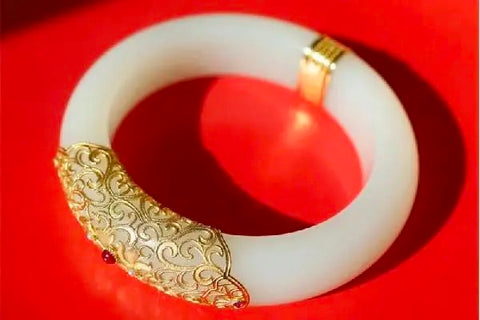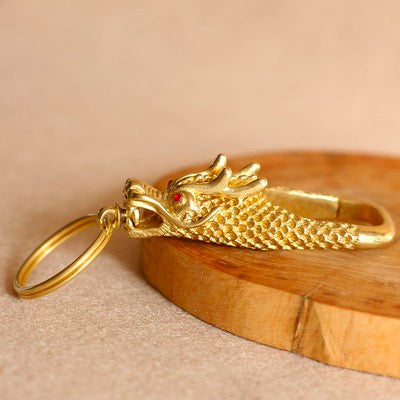Gold-inlaid jade, since ancient times, has been highly regarded by emperors and nobles. Not only is gold-inlaid jade exquisitely crafted and visually stunning, but its intricate craftsmanship also elevates the status of its collectors.
Professional Knowledge of Gold-Inlaid Jade - Origin of Gold-Inlaid Jade
As the saying goes, "Having eyes but failing to recognize gold-inlaid jade," this is a widely circulated idiom in our country, often used to describe people with limited insight and discernment.

This idiom originates from "Han Feizi's Commentary on the Book of Master Han Fei." According to legend, during the Spring and Autumn period, a man named Bian He from the State of Chu came across a beautiful piece of jade. He presented this jade to King Li of Chu and later to King Wu of Chu. Surprisingly, both kings dismissed the jade, cruelly cutting off Bian He's feet for attempting to deceive them.
Bian He cried bitterly at the foot of Mount Chu, and after King Wen of Chu ascended the throne, he heard about the incident and found it puzzling. He sent someone to inquire, and Bian He recounted his ordeal. King Wen ordered the jade to be split open, revealing a rare and precious gem inside. He then had the gem carved into a jade wall.
To honor Bian He's loyalty, King Wen named the jade wall "He Shi Bi." Since "He Shi Bi" was found in Jing Mountain in Baokang County, Hubei Province, it is also known as "Jing Mountain Jade."
Legend has it that the "He Shi Bi" remains warm in winter and cool in summer, and mosquitoes and flies do not approach within a hundred paces. Even Emperor Qin Shihuang, after unifying the six states, visited this miraculous "He Shi Bi." He had the jade crafted into a jade seal and carved the words "Appointed by Heaven, Eternal Longevity and Prosperity" along with a design of five dragons.
After the fall of the Qin Dynasty, "He Shi Bi" naturally passed into the hands of Liu Bang, the founder of the Han Dynasty. As a symbol of dynastic succession, it was passed down through generations as an imperial seal. In the late Western Han Dynasty, Emperor Wang Mang seized power, and to prevent Wang Mang from succeeding, Empress Dowager Xiaoyuan smashed the seal on the ground. Wang Mang was heartbroken and ordered craftsmen to repair it. The craftsmen had a creative idea - they inlaid the missing parts of the seal with gold, making it appear even more brilliant and dazzling. This is the origin of "gold-inlaid jade."
Unfortunately, the whereabouts of the "gold-inlaid jade seal" during the Three Kingdoms period remain unknown. However, the craftsmanship of gold-inlaid jade has been continuously passed down.
After the Ming Dynasty, people found the name "Jing Mountain Jade" less appealing than "gold-inlaid jade," which sounds more melodious. Therefore, the term "gold-inlaid jade" gradually replaced the former. The phrase "Having eyes but failing to recognize gold-inlaid jade" thus became popular among the people.
Professional Knowledge of Gold-Inlaid Jade - Craftsmanship of Gold-Inlaid Jade
In traditional Chinese culture, gold and jade symbolize nobility and purity. Their combination signifies a "golden jade union," a perfect blend that represents the dignity and auspiciousness of ancient emperors.
The term "gold-inlaid jade" refers to the practice of embedding various beautiful jades and exquisite gemstones onto golden ornaments. It is also known as "gold and silver inlaid with gemstone jade," a time-honored traditional handicraft unique to China.
The essence of gold-inlaid jade lies in the act of "inlaying." It involves continuously hammering gold wires or sheets into intricate patterns.
The craft of gold-inlaid jade originated from the gold and silver inlaying technique on bronze wares during the Shang and Zhou Dynasties. However, the artistry reached its zenith during the Ming and Qing Dynasties.
Legend has it that the technique of embedding gold and silver threads and gemstones was mastered by the Ming Dynasty jade carver Lu Zigang. Lu Zigang became a representative master of the gold-inlaid jade craft.
During the Qing Dynasty, particularly the Qianlong period, the craftsmanship reached an unprecedented level of excellence. Several Herati gold-inlaid jade artifacts offered as tributes by foreign nations gained the appreciation of Emperor Qianlong. He was enamored by these exquisite pieces and decided to keep them within the Forbidden City, making them exclusively available for the imperial palace's use. The palace artisans eventually developed the distinctive "Western designs" of gold-inlaid jade through persistent efforts.
However, due to the decline of the Qing Dynasty and the termination of the Imperial Household Department, the craftsmanship of gold-inlaid jade gradually faded. Today, only a few institutions such as the Palace Museum (Forbidden City) possess extant gold-inlaid jade artifacts.
Professional Knowledge of Gold-Inlaid Jade - Purchasing Gold-Inlaid Jade
Several key considerations when purchasing gold-inlaid jade jewelry:
Select a style of gold-inlaid jade that complements your facial and hand features.
Some jade jewelry may be adorned with other gemstones. During selection, pay close attention to signs of loose or dislodged gemstones.

When examining gold-inlaid jade jewelry, hold it and observe from various angles, inspecting for flaws or cracks.
When deciding to purchase, request a legitimate invoice and certificate from the seller.
Additionally, shine a flashlight behind the gold-inlaid jade to check if the gold layer is too thin, as it may peel off in the future.
Professional Knowledge of Gold-Inlaid Jade - Maintenance of Gold-Inlaid Jade
Avoid mixing gold-inlaid jade jewelry with other pieces to prevent collisions.
Handle gold-inlaid jade jewelry gently while wearing to avoid accidentally dropping it from a height. Despite jade's hardness, impact may still result in hidden cracks that affect its appearance.
Keep gold-inlaid jade jewelry away from environments prone to oil contamination, such as the kitchen. Oil residue may accumulate on the surface and dull its luster.
Avoid exposing gold-inlaid jade jewelry to direct sunlight or proximity to heat sources. Jade may expand with heat, potentially affecting its smooth texture.
Do not let gold-inlaid jade jewelry come into contact with dust. If dust accumulates, use a soft cloth or a brush to gently clean it.
Protect gold-inlaid jade jewelry from overly dry environments, as excessive dryness can cause the natural moisture within the jade to evaporate.
Keep gold-inlaid jade jewelry far from various chemicals, such as dish soap, soap, cosmetics, hair products, and perfumes. If accidentally exposed, promptly clean the jewelry or seek professional assistance.



















